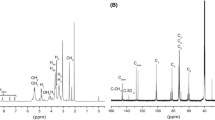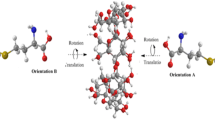Abstract
The association in aqueous solutions of small amphiphilic molecules [2-phenoxyethanol, PhE1, and some α-n-alkyl-ω-hydroxyoligo(oxiethylenes], C4E1, C4E2 and C6E2) with β-cyclodextrin (βCD), heptakis(2,6-di-O-methyl)-β-cyclodextrin (DIMEB) and heptakis(2,3,6-tri-O-methyl)-β-cyclodextrin (TRIMEB) was investigated by 1H NMR spectroscopy. The upfield shifts observed for the H3 and H5 NMR signals due to anisotropic shielding confirm that the host–guest associations are of inclusion type. The stoichiometries and the apparent inclusion constants, K app, were determined by 1H NMR spectroscopy using the H5 and H3 signals. The relative differences in the K app values for βCD inclusion complexes seem to reflect the hydrophobic/hydrophilic balance of the guests. The K app values for the PhE1 inclusion complexes can be related to the degree of methylation and hydrophobicity variation within the considered hosts. In addition, a comparative study between βCD and TRIMEB inclusion complexes using 2D ROESY (Rotating-frame Overhauser Enhancement SpectroscopY) NMR spectra provides structural features for these complexes which are inaccessible by other experimental methods.




Similar content being viewed by others
References
(a) Frömming, K.H., Szejtli, J.: Cyclodextrins in Pharmacy. Kluwer Academic Publishers (1994); (b) Saenger, W.: Cyclodextrin inclusion-compounds in research and industry. Angew. Chem. Int. Ed. Engl. 19, 344–362 (1980); (c) Gattuso, G.S., Nepogodiev, A., Stoddart, J.F.: Synthetic cyclic oligosaccharides. Chem. Rev. 98, 1919–1958 (1988)
(a) Khan, A.R., Forgo, P., Stine, K.J., D’Sousa, V.T.: Methods for selective modifications of cyclodextrins. Chem. Rev. 98, 1977–1996 (1998); (b) Jicsinsky, L., Fenyvesi, É., Hashimoto, H., Ueno, A.: In: Atwood, J.E., Davies, J.E.D., MacNicol, D.D., Vögtle, F., Lehn, J.-M., Szejtli, J., Osa, T. (eds.) Comprehensive Supramolecular Chemistry, vol. 3, cap. 4, pp. 57–188. Pergamon Oxford (1996)
Connors, K.: The stability of cyclodextrin complexes in solution. Chem. Rev. 97, 1325–1357 (1997)
Liu, L., Guo, Q.-X.: The driving forces in the inclusion complexation of cyclodextrins. J. Incl. Phenom. Macrocycl. Chem. 42, 1–14 (2002)
Szejtli, J.: Introduction and general overview of cyclodextrin chemistry. Chem. Rev. 98, 1743–1753 (1998)
(a) Lo Nostro, P., Lopes, J.R., Ninham, B.W., Baglioni, P.: Effect of cations and anions on the formation of polypseudorotaxanes. J. Phys. Chem. B 107, 2166–2174 (2002); (b) Del Valle, E.M.M., Cyclodextrins and their uses: a review. Proc. Biochem. 39, 1033–1046 (2004)
(a) Schick, M. J. (ed.): Nonionic Surfactants, Surfactant Science Series, vol. 23. Marcel Dekker Inc. New York (1987); (b) Turro, N.J., Kuo, P.C.: Fluorescence probes for aqueous-solution of non-ionic micelles. Langmuir 1, 170–172 (1985)
(a) Cunha-Silva, L., Teixeira-Dias, J.J.C.: Solid-state inclusion compounds of small amphiphilic molecules (CnEm) in beta-cyclodextrin: a study at defined relative humidities. New J. Chem. 29, 1335–1341 (2005); (b) Cunha-Silva, L., Teixeira-Dias, J.J.C.: How humidity affects the solid-state inclusion of 2-phenoxyethanol in beta-cyclodextrin: a comparison with beta-cyclodextrin. New J. Chem. 28, 200–206 (2004); (c) Cunha-Silva, L., Teixeira-Dias, J.J.C.: Aqueous solution inclusion of the nonionic surfactant C12E4 in betacyclodextrin: Implications of micellization in stoichiometry determination and model calculations. J. Incl. Phenom. Macrocycl. Chem. 43, 127–131 (2002)
(a) Schneider, H.J., Hacket, F., Rudiger, V., Ikeda, H.: NMR studies of cyclodextrins and cyclodextrin complexes. Chem. Rev. 98, 1755–1785 (1998); (b) Loftsson, T., Másson, M., Brewster, M.E.: Self-association of cyclodextrins and cyclodextrin complexes. J. Pharm. Sci. 93, 1091–1099 (2004)
(a) Demarco, P.V., Takkar, A.L.: Cyclohepta-amylose. A proton magnetic resonance study. J. Chem. Soc. Chem. Commun. 2–4 (1970); (b) Inoue, Y.: NMR studies of the structure and proprieties of cyclodextrins and their inclusion complexes. Ann. Rep. NMR Spectrosc. 27 60–101 (1993)
Job, P.: Recherches sur la formation de complexes minéraux en solution, et sur leur stabilité. Ann. Chim. 9, 113–203 (1928)
(a) Funasaki, N., Nomura, M., Ishikawa, S., Neya, S.: NMR chemical shift references for binding constant determination in aqueous solutions. J. Phys. Chem. B 105, 7361–7365 (2001); (b) Gottlieb, H.G., Kotlyar, V., Nudelman, A.: NMR chemical shifts of common laboratory solvents as trace impurities. J. Org. Chem. 62, 7512–7515 (1997)
Funasaki, N., Ishikawa, S., Neya, S.: Proton NMR study of alpha-cyclodextrin inclusion of short-chain surfactants. J. Phys. Chem. B 107, 10094–10099 (2003)
Benesi, A., Hildebrand, J.H.: A spectrophotemetric investigation of the interaction of iodine with aromatic hydrocarbons. J. Am. Chem. Soc. 71, 2703–2707 (1949)
Silva, A.M., Empis, J., Teixeira-Dias, J.J.C.: Inclusion of enantiomeric carvones in beta-cyclodextrin: a variable temperature H-1 NMR study in aqueous solution. Chem. 33, 81–97 (1999)
Gunther, H.: (1995) NMR Spectroscopy, 2nd ed. John Wiley & Sons, Chichester, England p. 339
Hamad, E.Z., Mansoori, G.A.: A fluctuation solution theory of activity.coefficients - phase-equilibria in associating molecular solutions. J. Phys. Chem. 94(7), 3148–3152 (1990)
(a) Fielding, L.: Determination of association constants (Ka) from solution NMR data. Tetrahedron 56, 6151–6170 (2000); (b) Yang, C., Liu, L., Mu, T.-W., Guo, Q.-X.: Improved accuracy and efficiency in the determination of association constants with the spectrophotometric method. J. Incl. Phenom. Macrocycl. Chem. 39, 97–101 (2001)
Acknowledgements
C. Andrade-Dias and L. Cunha-Silva (BD/1101/2000 and BPD/14410/2003) thank Fundação para a Ciência e a Tecnologia, Ministério da Ciência, Tecnologia e Ensino Superior, Portugal, for financial support
Author information
Authors and Affiliations
Corresponding author
Rights and permissions
About this article
Cite this article
Andrade-Dias, C., Goodfellow, B.J., Cunha-Silva, L. et al. Inclusion complexes of 2-phenoxyethanol and alkoxyethanols in cyclodextrins: an 1H NMR study. J Incl Phenom Macrocycl Chem 57, 151–156 (2007). https://doi.org/10.1007/s10847-006-9204-0
Received:
Revised:
Accepted:
Published:
Issue Date:
DOI: https://doi.org/10.1007/s10847-006-9204-0




